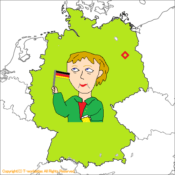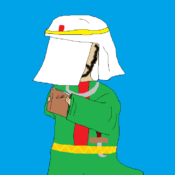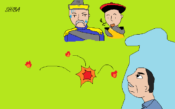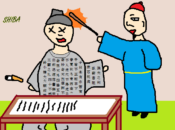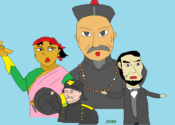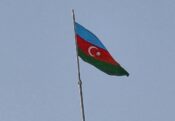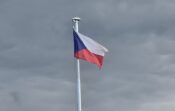6世紀~復活する大帝国~ The Great Empire Returns
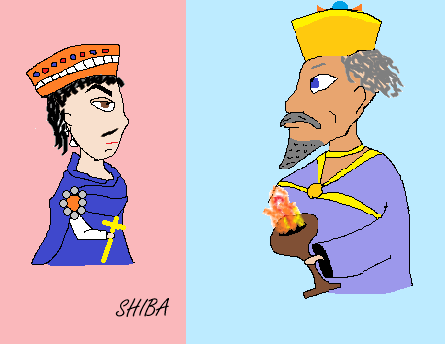
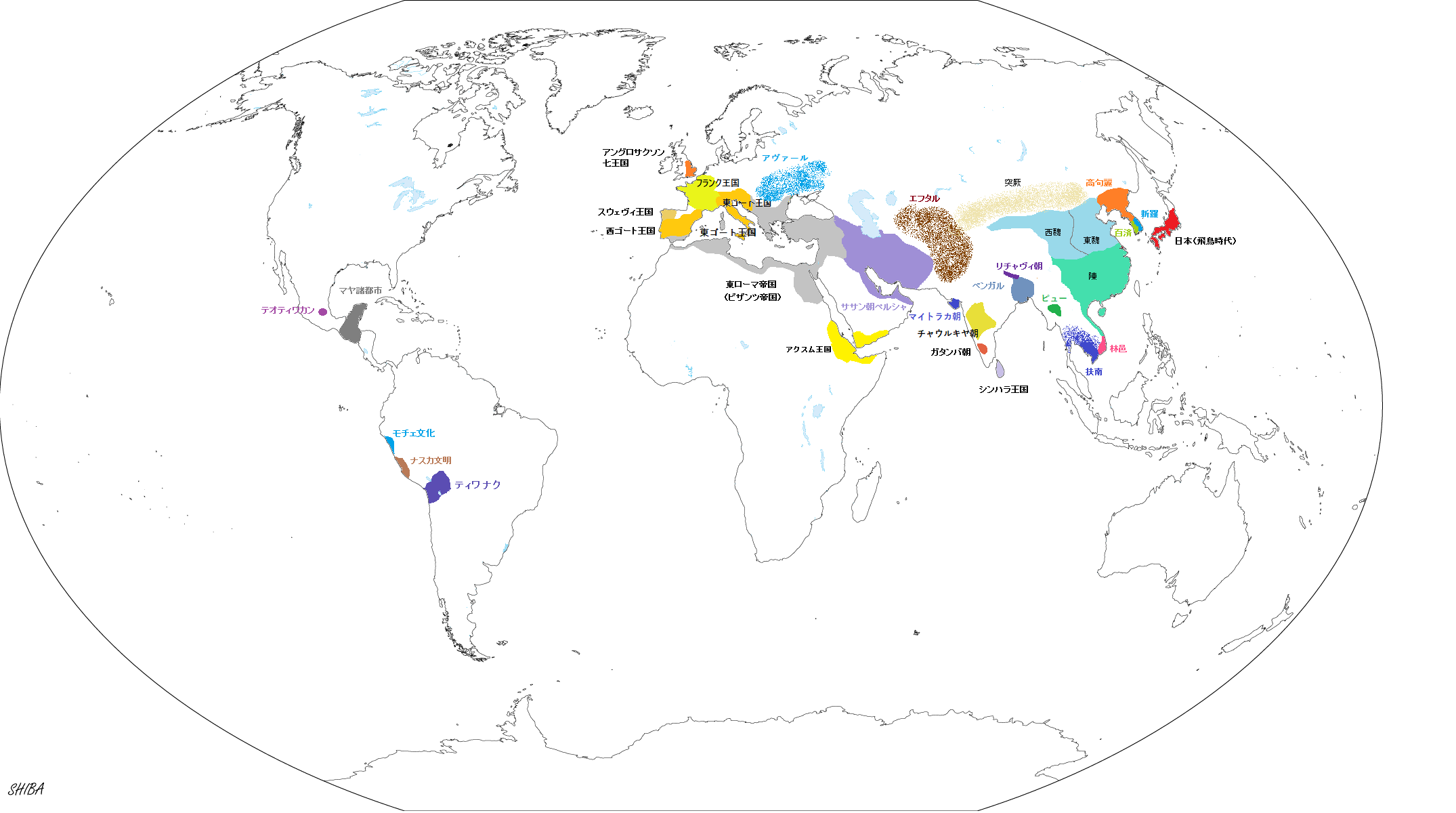
前(5世紀~世界を揺るがした遊牧民族~) ← → 次(7世紀~イスラムの誕生と唐の繁栄~)
6世紀の世界を一言で言うのは難しいのですが、衰退の色を見せていた西アジアの帝国が復活した点、中国の分裂時代がようやく終わりを告げた点、他方ヨーロッパではまだまだ混迷が続いていた点などが挙げられます。
While it’s difficult to summarize the 6th century world in a single phrase, some notable points include: the revival of empires in West Asia that had been showing signs of decline, the end of China’s period of division, and, on the other hand, the continued turmoil in Europe.
東アジア
中国
中国は長年続いた南北朝時代に終わりが見えてきます。北朝の北魏は、元々北方の遊牧民である鮮卑が開いた王朝でしたが、この国を5世紀末まで統治していた孝文帝は、漢民族の文化を積極的に取り入れていました。
The end of the long-lasting Southern and Northern Dynasties period in China was approaching. The Northern Wei(北魏) of the Northern Dynasties was originally founded by the Xianbei(鮮卑), a nomadic people from the north. Emperor Xiaowen(孝文帝), who ruled this dynasty until the end of the 5th century, actively embraced Han Chinese culture.
しかしこの結果漢民族が官僚として重んじられ、一方で多くの遊牧民は冷遇されます。こうした不満を持つ人々は523年六鎮の乱を起こし、これがきっかけで北魏は534年に分裂(西魏、東魏)。更にこの2つの王朝もそれぞれ別の一族に乗っ取られてしまい、新たに北斉、北周が成立。577年には、北周が北斉を倒して北朝を統一しますが、北魏のような安定した政権を続けるには至りませんでした。
However, this resulted in Han Chinese being favored as officials, while many nomads were treated poorly. Dissatisfied people sparked the Six Garrisons Revolt (六镇之乱) in 523, leading to the split of Northern Wei in 534 into Western Wei (西魏) and Eastern Wei (東魏).
These two dynasties were subsequently usurped by different clans, forming the Northern Qi (北斉) and Northern Zhou (北周). In 577, Northern Zhou defeated Northern Qi to unify the north, but failed to establish a stable regime like Northern Wei.
南朝では前半が梁、後半が陳の統治するところとなります。梁の武帝は、南朝の皇帝で最も長く皇帝の地位にあった人物(502~549年)で、南朝のひとつの頂点でした。彼の皇子昭明太子は、南北朝時代の名文学を『文選』にまとめ上げるなどの業績をのこしています。
In the Southern Dynasties, the first half was ruled by Liang (梁)and the latter half by Chen(陳). Emperor Wu of Liang (梁武帝/萧衍)was the longest-reigning emperor in the Southern Dynasties (502-549) and represented a peak of the era. His son, Crown Prince Zhaoming (昭明太子/萧统), compiled the “Wen Xuan(文選),” an anthology of notable literature from the Southern and Northern Dynasties period.
この時代、インドで衰退していた仏教が中国では隆盛。ダルマのモデルとなった達磨大師がインドから梁王朝へやってきて、禅宗を伝えました。しかし武帝の退位後は梁も力を失い、続く陳王朝も弱小国家でした。
During this time, Buddhism, which had declined in India, flourished in China. Bodhidharma (菩提达摩), came from India to the Liang Dynasty and introduced Zen Buddhism (禅宗).
581年北朝の北周から帝位を奪って隋を建てた楊堅(文帝)は、589年に陳を滅ぼして、西晋以来265年ぶりに中国全土を統一しました。
However, after Emperor Wu’s abdication, Liang lost power, and the subsequent Chen Dynasty was a weak state. In 581, Yang Jian (杨坚) ,Emperor Wen(文帝), usurped the throne from Northern Zhou of the Northern Dynasties and built Sui(隋). In 589, he defeated Chen, unifying China for the first time in 265 years since Western Jin(西晋).
都を長安の一角(大興城)に置いた文帝は、中央から官僚を派遣する州県制を敷き、また貴族の力を抑えるべく、試験で官僚を採用する制度、すなわち「科挙」を導入しました。隋における科挙はまだ部分的なものでしたが、時代とともにそのウェイトは大きくなっていきます。
Emperor Wen established his capital in a corner of Chang’an(长安), (Daxing City/大興城) and implemented a centralized bureaucratic system by dispatching officials from the central government. To curb the power of aristocrats, he introduced the imperial examination system, or “keju(科举)/ imperial examination,” for recruiting officials. Although the keju system in Sui was still limited, its importance grew over time.
朝鮮
朝鮮半島では、高句麗、百済、新羅の3か国が出揃い、各々が国力を高めていきます。
On the Korean Peninsula, the three kingdoms of Goguryeo(高句麗/고구려), Baekje(百済/백제), and Silla(新羅/신라) emerged, each growing in national power.
5世紀後半、王都漢城(現ソウル)を高句麗に奪われた百済は、新都の 熊津にて502年に即位した 武寧王の元で再建されます。武寧王は自分の王族に地方を統治させることで、国内の統合を進め、自分に権力を集中。また、高句麗との対抗上、同盟国日本との関係を緊密化しました。
After Baekje lost its capital Hanseong (漢城/한성:present-day Seoul) to Goguryeo in the late 5th century, it was rebuilt under King Muryeong(武寧/무령), who ascended to the throne in 502 in the new capital of Ungjin(熊津/웅진). King Muryeong consolidated power by having members of his family govern local regions, thus unifying the country and centralizing authority. He also strengthened relations with Japan, an ally, to counter Goguryeo.
523年武寧王を継いだ 聖王は、538年に 泗沘(現 扶余)に都を遷し、高句麗との戦いに備えました。すでに仏教が広まっていた百済から、日本へ仏教が伝わったのも538年頃とされます。
King Seong(聖/성), who succeeded King Muryeong in 523, moved the capital to Sabi (사비:present-day Buyeo) in 538 to prepare for battles against Goguryeo. It is also said that Buddhism, which had already spread in Baekje, was introduced to Japan around 538 .
後に朝鮮半島最大勢力となる新羅は、503年に 斯盧から国名を変更されて誕生します。514年新羅王となった法興王は、武寧王と同様に自らに権力を集中させ、国内を強化。花郎というエリート軍人も彼の時代に生まれたと考えられています。外交面では中国の南朝(当時は梁王朝)との関係を重視しました。527年には中国経由で伝わった仏教を受け入れ、王都慶州にも多くの寺院を築きました。
Silla, which later became the dominant power on the Korean Peninsula, was born in 503 when its name was changed from Saro(斯盧/사로). King Beopheung(法興/법흥), who ascended to the throne in 514, concentrated power in himself and strengthened the kingdom. The Hwarang(花郎/화랑), an elite group of warriors, is believed to have originated during his reign. In terms of foreign relations, he prioritized ties with the Southern Dynasties of China (the Liang Dynasty at the time). In 527, he accepted Buddhism, which had been transmitted via China, and built many temples in the capital city of Gyeongju(慶州/경주).
540年即位した真興王は、共通の敵である高句麗と戦うため、百済の聖王と同盟。551年百済の旧都である漢城を奪還しますが、間もなく新羅側がこの街を奪い取ってしまいました。更に新羅は南部の加耶諸国にも進出し、562年までにこれを併合しました。
King Jinheung(眞興/진흥), who ascended to the throne in 540, allied with King Seong of Baekje to fight their common enemy, Goguryeo. In 551, they recaptured Hansan, the former capital of Baekje, but soon after, Silla seized this city for itself. Furthermore, Silla expanded into the southern Gaya(加耶/가야) confederacy, annexing it by 562.
日本
日本ではこの頃、ヤマト政権が九州の大勢力だった磐井を倒すなどして、全国の統一を進めていました。それと同時に大陸の国から多くの渡来人を受け入れていきました。前述のとおり538年頃には、朝鮮半島でも特に友好関係にあった百済から日本に仏教が伝わります。しかし日本には古来より神道という宗教があり、仏教の受け入れには朝廷内でも意見が分かれます。
In Japan during this period, the Yamato Kingship was advancing the unification of the country by defeating powerful factions, such as Iwai,(磐井) who held significant influence in Kyushu(九州: the island in the southwest of Japan). At the same time, they welcomed many immigrants from continental states. As previously mentioned, around 538, Buddhism was introduced to Japan from Baekje, a kingdom on the Korean Peninsula with particularly friendly ties to Japan. However, Japan already had an indigenous religion called Shinto(神道), and the acceptance of Buddhism caused divisions of opinion within the imperial court.
この結果、朝廷内の有力豪族、蘇我氏(親仏教)と物部氏(反仏教)の権力争いと結びつき、騒乱が起こります。この争いは蘇我氏の勝利に終わり、その当主 蘇我馬子は、敵対した 大王を暗殺するなど、強権をふるいました。593年推古天皇が即位。史上初の女性天皇(大王)です。彼女をサポートすべく摂政となったのが、厩戸皇子こと聖徳太子でした。聖徳太子は蘇我馬子と協力し、時に敵対しながら、ヤマト政権を支えていくことになります。
As a result, this became intertwined with the power struggle within the imperial court between the influential clans—the pro-Buddhism Soga(蘇我) clan and the anti-Buddhism Mononobe(物部) clan—leading to unrest. The conflict ended with the Soga clan’s victory, and their leader, Soga no Umako(蘇我馬子), wielded significant authority, even going so far as to assassinate the opposing Ōkimi (大王:emperor). In 593, Empress Suiko(推古天皇) ascended to the throne, becoming the first Empress in Japanese history. To support her reign, Prince Umayado(厩戸皇子), also known as Prince Shōtoku(聖徳太子), was appointed regent. Prince Shōtoku collaborated with Soga no Umako, sometimes working together and at other times clashing, to uphold the Yamato Kingship.

モンゴル・中央アジア
モンゴル高原を支配していた遊牧民柔然は、6世紀に入る頃には衰退し、別の遊牧民にとってかわられていきます。その一派は中国の文献で「突厥」あるいは「鉄勒」と記され、これが「トルコ」の語源ではないかと考えられています。突厥は555年に柔然を滅ぼし、草原を経て中央アジアまでを支配しました。最盛期の6世紀後半に突厥の範囲はモンゴル高原からイランに至る広大ものとなったため、間もなく東西に分裂しました。
The nomadic Rouran(柔然), who controlled the Mongolian Plateau, began to decline around the 6th century and were replaced by another nomadic group. This group was recorded in Chinese documents as “Turks”(突厥) or “Tiele”(鉄勒), which is believed to be the origin of the word “Turkey”. The Turks destroyed the Rouran in 555 and came to rule from the steppes to Central Asia. At its peak in the latter half of the 6th century, the Turks territory extended from the Mongolian Plateau to Iran, becoming so vast that it soon split into eastern and western regions.
なお、突厥は独自の文字を持っていましたが、この突厥文字の元となったのが、現在のウズベキスタン、タジキスタン周辺に住んでいたソグド人の用いるソグド文字でした。ソグド人は大きな国を築くことはなかったものの、古くからシルクロード交易に積極的に関わり、多くの商品とともに文化、思想、宗教などを東西に伝えました。
Turks had their own script, and the origin of this Turks script was the Sogdian script used by the Sogdians, who lived in the area around present-day Uzbekistan and Tajikistan. Although the Sogdians never built a large nation, they were actively involved in Silk Road trade from ancient times, transmitting not only goods but also culture, ideas, and religions between East and West.
西アジア
当時のイラン周辺にはまた、遊牧民エフタルも強い勢力を保っていました。エフタルはインドのグプタ朝を滅ぼし、当時中東一帯を支配していたササン朝ペルシャに対しても貢ぎ物を要求するなど、ペルシャ王にとっては悩みの種でした。そこに現れたのが新興勢力の突厥。ササン朝は558年に突厥の君主木杆可汗と手を組み、6世紀半ばにエフタルを壊滅させます。これを成し遂げたのが、ササン朝随一の名君、ホスロー1世でした。彼の時代領地も広がり、多くのペルシャ風美術も発展しています。
At that time, the nomadic Hephthalites also maintained a strong presence around Iran. The Hephthalites had destroyed the Gupta Empire in India and even demanded tribute from the Sasanian Persian Empire, which ruled much of the Middle East at the time, making them a thorn in the side of the Persian king. It was then that the emerging power of the Turks appeared. The Sasanian Empire allied with Muqan Qaghan, the ruler of the Turks, in 558 and annihilated the Hephthalites in the mid-6th century. This feat was accomplished by Khosrow I, considered the greatest monarch of the Sasanian dynasty. During his reign, the empire’s territory expanded, and many Persian-style arts flourished.
一方、ササン朝には西側にも宿敵がいました。東ローマ帝国です。この帝国に対しては、後述のユスティニアヌス1世と何度か激突。この時双方が傭兵として雇ったのが、イスラム教誕生前夜の遊牧民アラブ人でした。しかし560年頃に両者は講和条約を結んで、お互いの支配域を確保しました。数十年後これが破られた時、ササン朝は滅亡への第一歩を踏み出すことになります。
Meanwhile, the Sassanid Empire had another enemy to the west as well: the Eastern Roman Empire. They clashed several times with Justinian I (mentioned later). Both sides employed Arab nomads as mercenaries, just before the birth of Islam. However, around 560, the two empires signed a peace treaty, securing their respective territories. When this treaty was broken several decades later, the Sassanid Empire would take its first step towards its downfall.
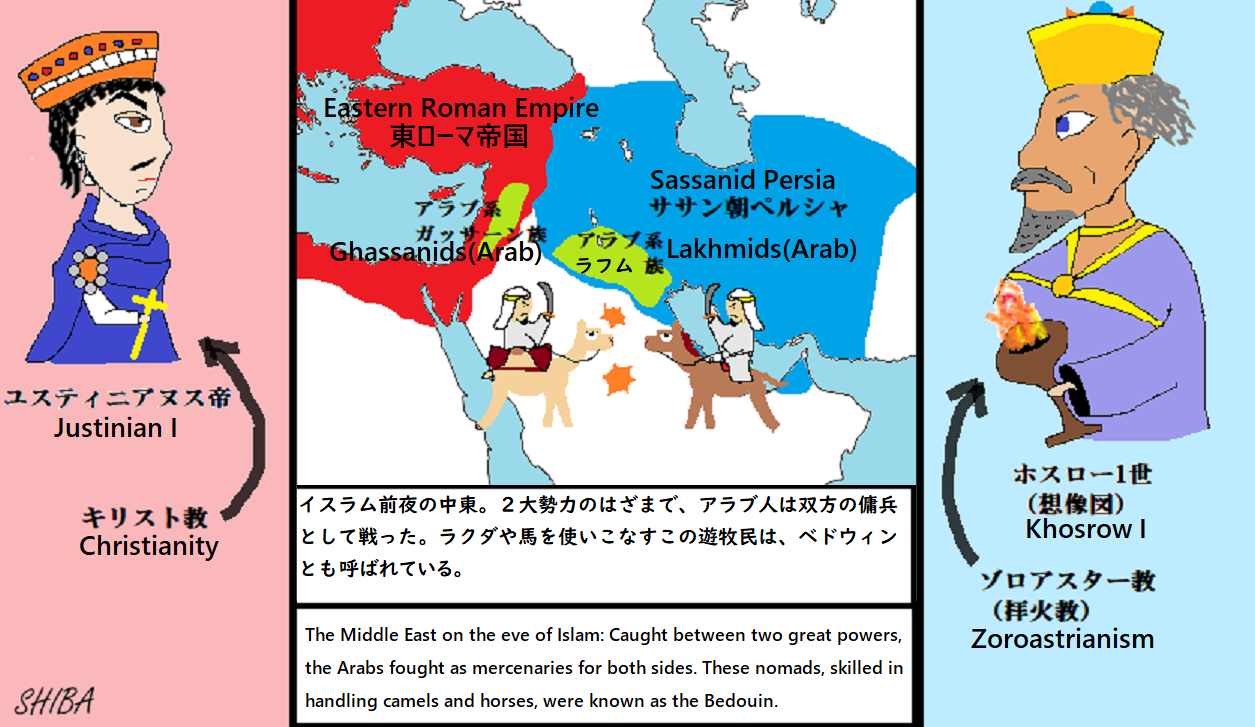
イエメン・エチオピア
アラビア半島南端のイエメンでは、紅海を経由した貿易により、ヒムヤル王国が栄えていました。繰り返しになりますが、6世紀にはまだイスラム教は誕生しておらず、アラブ人もキリスト教やユダヤ教、伝統的な宗教を信仰していました。この頃はヒムヤル国内に様々な宗教、様々な宗派の人が混在していたというワケです。
At the southern tip of the Arabian Peninsula, in Yemen, the Kingdom of Himyar flourished through trade via the Red Sea. Islam had not yet emerged in the 6th century, and Arabs followed various faiths including Christianity, Judaism, and traditional religions. During this period, people of various religions and sects coexisted within the Himyar kingdom.
紅海を挟んだ対岸(アフリカ大陸)にはキリスト教系のアクスム王国(現エチオピア)が拡大を続けており、ヒムヤルの王位にも口を出すようになっていきました。6世紀初め、アクスム王国のテコ入れでキリスト教徒のヒムヤル王が誕生すると、これに反発したユダヤ教徒のズー・ヌワースが反乱を起こし、522年ヒムヤルの王位を奪います。彼は王国内のキリスト教徒を多数殺害したため、怒ったアクスム王国が525年侵攻し、ズー・ヌワースを打倒。紀元前から続いていたヒムヤル王国はこれをもって事実上崩壊しました。
Across the Red Sea, on the African continent, the Christian kingdom of Aksum (present-day Ethiopia) was expanding and began to interfere in Himyar’s royal succession. In the early 6th century, when a Christian Himyarite king ascended to the throne with Aksum’s support, a Jewish leader named Dhu Nuwas rebelled in opposition and seized the Himyarite throne in 522. He killed many Christians in the kingdom, which angered Aksum and led to their invasion in 525, overthrowing Dhu Nuwas. This effectively marked the collapse of the Himyar kingdom, which had existed since ancient times.
ところが560年代になると、アクスムの支配を嫌う人々から依頼されたササン朝が侵攻し、アクスム勢力をアラビア半島から追い出しました。こうしてイエメンは、ササン朝の支配下に入ることになります。
However, in the 560s, the Sassanid Empire, responding to requests from those who disliked Aksumite rule, invaded and expelled the Aksumite forces from the Arabian Peninsula. As a result, Yemen came under Sassanid control.
東ヨーロッパ
現在のバルカン半島、ギリシャ、トルコ、イスラエル、シリア、エジプトなどを支配していた東ローマ帝国は、キリスト教の大国でした。5世紀にはゲルマン人の侵入に悩まされていましたが、6世紀初頭に皇帝アナスタシウス1世が財政改革で税金をより着実に納めさせる仕組みを作り、これによって収入が安定化します。527年に即位したユスティニアヌス1世は、この財を周囲への軍事費に充てて、帝国を強大化させました。
The Eastern Roman Empire, which ruled over present-day Balkans, Greece, Turkey, Israel, Syria, and Egypt, was a major Christian power. While troubled by Germanic invasions in the 5th century, Emperor Anastasius I implemented fiscal reforms in the early 6th century, creating a system for more reliable tax collection, which stabilized revenue. Justinian I, who ascended to the throne in 527, used these funds to strengthen the empire through military expenditures on surrounding areas.
ユスティニアヌス1世は534年にローマ時代の法制度を再編した『ローマ法大全』を完成させて支配を強化。皇帝の力を高めた上で西方へと進軍し、イタリア半島にあった東ゴート王国や、北アフリカに栄えていたヴァンダル王国を征服します。彼のもとで栄光のローマ帝国が復活したかに見えました。しかし強引な征服活動によって財政はまた悪化し、ユスティニアヌスの死後、イタリアや北アフリカの支配が難しくなっていきました。時の移ろいによりローマ帝国はもう必要とされなくなっていたのです。
Justinian I completed the “Corpus Juris Civilis” in 534, reorganizing Roman legal institutions to consolidate his rule. After enhancing imperial power, he advanced westward, conquering the Ostrogothic Kingdom in the Italian Peninsula and the Vandal Kingdom in North Africa. It seemed as if the Roman Empire had been revived under his rule. However, aggressive conquest activities again deteriorated the finances, and after Justinian’s death, control over Italy and North Africa became increasingly difficult. The passage of time showed that The Roman Empire was no longer needed.
ところで古代ローマ帝国は公用語にラテン語を使っていました。しかし東ローマ帝国の都はギリシャに近いコンスタンティノープル。帝国の人々はこの頃から次第にラテン語ではなくギリシャ語を使うようになりました。かといって古代ギリシャの思想が重んじられたわけではありません。かつてプラトンが創設したギリシャ哲学の学問所アカデメイアを、ユスティニアヌス1世は即位直後の529年に閉鎖しました。理由は「キリスト教の教えに反することを教えていたから」というもの。
By the way, the ancient Roman Empire used Latin as its official language. But the Eastern Roman Empire’s capital was Constantinople, close to Greece. During this period, the people of the empire gradually shifted from using Latin to Greek. However, this did not mean that ancient Greek civilization was highly regarded. Justinian I closed the Platonic Academy, the center of Greek philosophical studies founded by Plato, immediately after his accession in 529. The reason given was that “it taught doctrines contrary to Christian teachings.”
こうして古代ギリシャの精神もこの地から次第に消え、東ローマ帝国はギリシャともローマとも異なる国、すなわち現在「ビザンツ帝国」と呼ばれる国へと変貌を遂げていきます。
Thus, as the spirit of ancient Greece gradually disappeared from this land, the Eastern Roman Empire transformed into a country different from both Greece and Rome, now known as the “Byzantine Empire.”
西ヨーロッパ
東ローマ帝国が勢力を拡大する一方、西ローマ帝国はすでになく、西ヨーロッパではゲルマン民族の王国が覇を争う時代を迎えていました。混乱の中、人々の心の拠り所となったのがキリスト教(ローマカトリック)でした。
While the Eastern Roman Empire was expanding its influence, the Western Roman Empire had already fallen, and Western Europe entered an era where Germanic kingdoms vied for supremacy. Amidst this turmoil, Christianity (Roman Catholicism) became a spiritual anchor for people.
ただ、教会組織も大きくなるにつれて権力争いや腐敗がひどくなっていきます。こうした争いから距離を置き、人々のために「祈り、働き」ながら慎ましい生活をする人々も出てきました。これが修道士であり、彼らの暮らした場所が修道院でした。イタリアにモンテ・カシノ修道院を建てた聖ベネディクトゥスは、6世紀の代表的な修道士です。
However, as the church organization grew, power struggles and corruption worsened. Some people began to distance themselves from these struggles, choosing to live modest lives ‘praying and working’ for the people. These were monks, and the places where they lived were monasteries. Saint Benedict, who built the Monte Cassino monastery in Italy, was a prominent monk of the 6th century.
そのイタリアは、6世紀初頭の段階では大部分が東ゴート王国の統治下にありましたが、前述のように、その半ばには東ローマ帝国に征服されました。この時東ローマの政治制度に影響されたのか、ローマ教会は次第にトップの権威が強い組織へと発展していきました。その組織化を完成させたとされるのが6世紀末に登場したグレゴリウス1世で、それゆえ最初の「ローマ教皇(法王)」という言われ方もします。グレゴリウス1世は、カトリックを持って西ヨーロッパの安定化をはかろうと、ゲルマン民族への布教を積極的に行いました。キリスト教が広まる一方で、古代ギリシャやローマの学問、思想、技術などは失われていきました。
At the beginning of the 6th century, most of Italy was under the rule of the Ostrogothic Kingdom, but as mentioned above, it was conquered by the Eastern Roman Empire in the middle of the century. Perhaps influenced by the Eastern Roman political system, the Roman Church gradually developed into an organization with strong top-down authority. Gregory I, who appeared at the end of the 6th century, is said to have completed this organization, and is thus sometimes called the first “Roman Pope”. Gregory I actively sought to evangelize Germanic tribes to stabilize Western Europe through Catholicism. While Christianity spread, the learning, philosophy, and technology of ancient Greece and Rome were gradually lost.
さて、そのゲルマン民族が建てた国ですが、現在のフランスからドイツにかけての広い範囲を統治したのが、フランク王国です。その国王クローヴィスは6世紀初頭にいち早くローマカトリックを受け入れました。現在の南フランスには、別系統のゲルマン系ブルグンド人が住んでいましたが、534年フランク王国に征服されました。こうして見かけ上、大国となっていったフランク王国でしたが、面積が広いがゆえに何度も分裂と再統合を繰り返すなど、まだまだ不安定な国でした。
Among the nations established by Germanic peoples, the Frankish Kingdom ruled a wide area from present-day France to Germany. Its king, Clovis, was one of the first to accept Roman Catholicism in the early 6th century. The Burgundians, another Germanic group, lived in what is now southern France but were conquered by the Frankish Kingdom in 534. Although the Frankish Kingdom appeared to become a great power, it was still unstable, repeatedly splitting and reunifying due to its vast territory.
イギリス(グレートブリテン島)には主にアングロ人、サクソン人が移住し、先住のブリトン人を吸収しながら各地に王国を築いていきます。その中でもノーサンブリア王国、マーシア王国、ウェセックス王国など7つの王国が強大だったことから、後年これらはまとめて「ヘプターキー(ヘプタ:7の意)」と呼ばれました。
In Britain, mainly Angles and Saxons migrated, absorbing the native Britons and establishing kingdoms in various regions. Seven of these kingdoms, including Northumbria, Mercia, and Wessex, became powerful and were later collectively called the “Heptarchy”.
東ローマ帝国に征服されたイタリア半島は、ユスティニアヌス1世の死後間もなくその支配が緩んでいきます。そしてその北部にはゲルマン系のランゴバルド人が侵攻し、自身の王国を築きました。こうしてイタリア半島は南北に分断されることになります。
The Italian Peninsula, conquered by the Eastern Roman Empire, saw its control weaken shortly after Justinian I’s death. The Lombards, a Germanic people, invaded northern Italy and established their own kingdom, effectively dividing the peninsula.
スペイン・ポルトガルにあたるイベリア半島は、西ゴート人、スエヴィ人が覇を争っていました。568年西ゴート王となったレオヴィギルドは、585年にスエヴィ王国を倒してイベリア半島の大半を統一することに成功します。彼は先住のローマ人(ラテン系)と自分たち西ゴート人(ゲルマン系)の融和にも努めましたが、まだ法律などは別々の状態でした。
In the Iberian Peninsula, corresponding to Spain and Portugal, Visigoths and Suevi vied for supremacy. Leovigild, who became the Visigothic king in 568, succeeded in unifying most of the Iberian Peninsula by defeating the Suevic Kingdom in 585. He also worked towards reconciling the native Romans (Latin) with the Visigoths (Germanic), though laws remained separate.
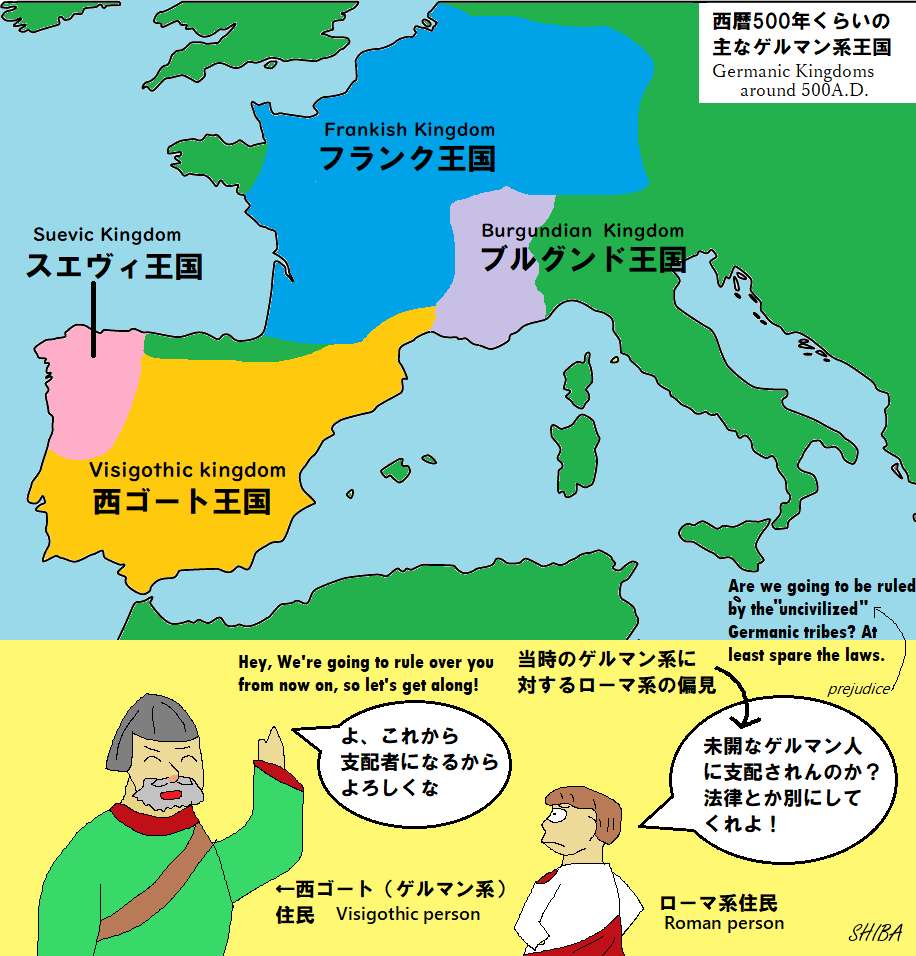
世界史に(あまり)出てこない国の歩み~ポルトガルの歴史~ より
ところで、こうしたゲルマン民族の王国は、数世紀前から始まった民族大移動の末に築かれたものでした。この大移動に拍車をかけたのが、5世紀に東からやってきた遊牧民国家フン族だったことは前章で触れました。同様に6世紀にも東からアヴァールと呼ばれる別の遊牧民がやって来ます。アヴァールはヨーロッパの中央部にまで進出しましたが、この時にも別の民族移動を引き起こします。
These Germanic kingdoms were established at the end of the great migrations that had begun centuries earlier. As mentioned in the previous chapter, the nomadic Hunnic Empire arriving from the east in the 5th century accelerated these migrations. Similarly, in the 6th century, another nomadic group called the Avars came from the east. The Avars advanced into central Europe, triggering further migrations.
その最大のものが、スラヴ系の人々でした。スラヴ人が元々どこに住んでいたのかには諸説ありますが、このアヴァールに従うように移動し、東ヨーロッパ各地に根を下ろしました。彼らは後の時代にポーランド、チェコ、セルビア、クロアチアといった国を築くことになります。
The largest of these involved Slavic peoples. While there are various theories about where the Slavs originally lived, they settled in various parts of Eastern Europe in conjunction with the Avars. These Slavs would later establish countries such as Poland, Czech Republic, Serbia, and Croatia.
~主な出来事~
511 クローヴィス死去。フランク王国息子らにより4分割(西ヨーロッパ)
525 アクスム王国、イエメンのヒムヤル王国を征服(アラビア半島)
529頃 ヴェネディクトス、モンテ・カシノ修道院建設(イタリア・西ヨーロッパ)
534 ローマ法大全完成(ビザンツ帝国)
534 北魏、東西に分裂(中国)
538頃 百済から日本に仏教伝来(東アジア)
550頃 グプタ朝滅亡(インド)
デカン高原にチャウルキヤ朝成立(インド)
555 モンゴル高原の柔然滅亡 突厥台頭(東アジア)
555 ユスティニアヌス1世、イタリア半島の東ゴート王国を滅ぼす(ビザンツ帝国)
562 新羅、大加耶併合(朝鮮半島)
562 マヤの都市カラクムル、ティカルを攻撃 ティカル一時衰退(中米・マヤ文明)
567 ホスロー1世、エフタルを滅ぼす(西アジア)
568 北イタリアにランゴバルド王国成立(イタリア)
575 ササン朝侵攻、ヒムヤル王国名実ともに滅亡(アラビア半島)
587 蘇我馬子、物部氏を滅ぼす(日本)
589 隋の楊堅、陳王朝を併合し、南北朝統一(中国)
590 グレゴリウス1世、ローマ教皇に即位。(ヨーロッパ)
593 推古天皇即位、聖徳太子摂政就任(日本)
前(5世紀~世界を揺るがした遊牧民族~) ← → 次(7世紀~イスラムの誕生と唐の繁栄~)
